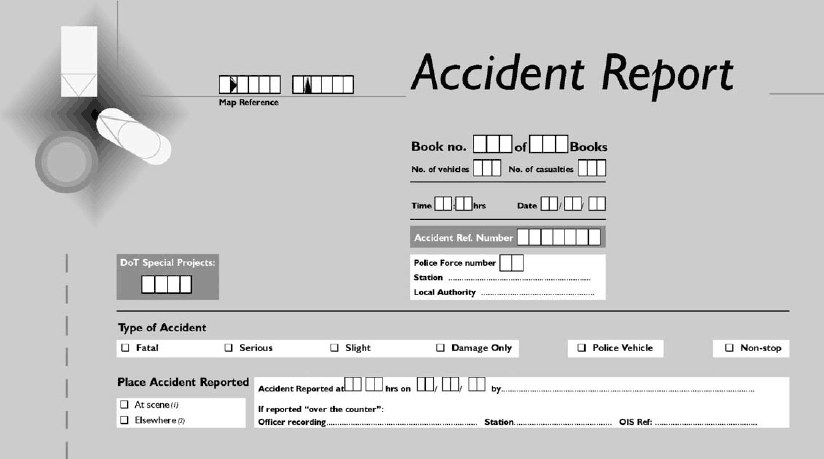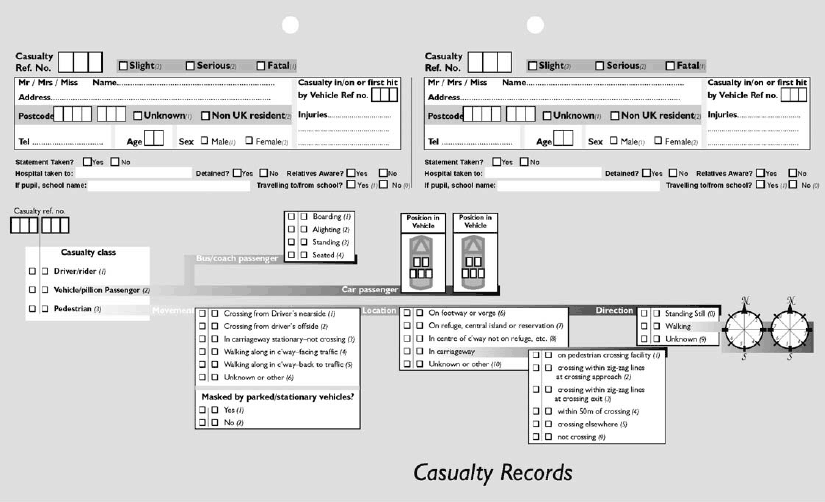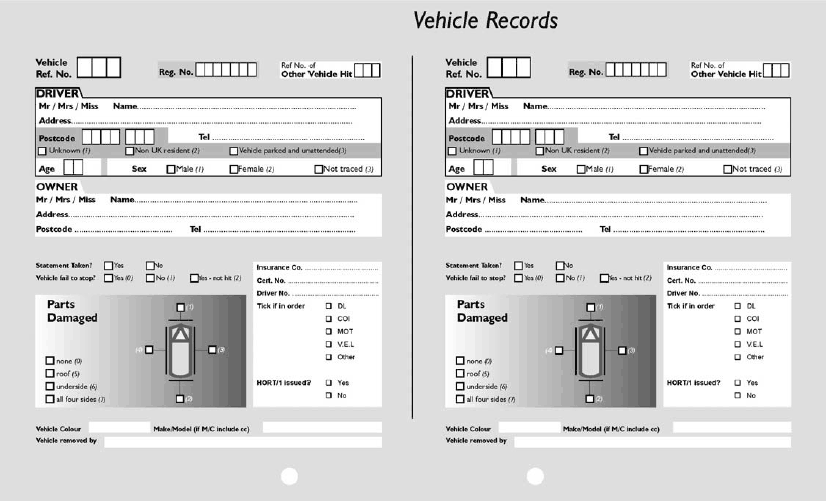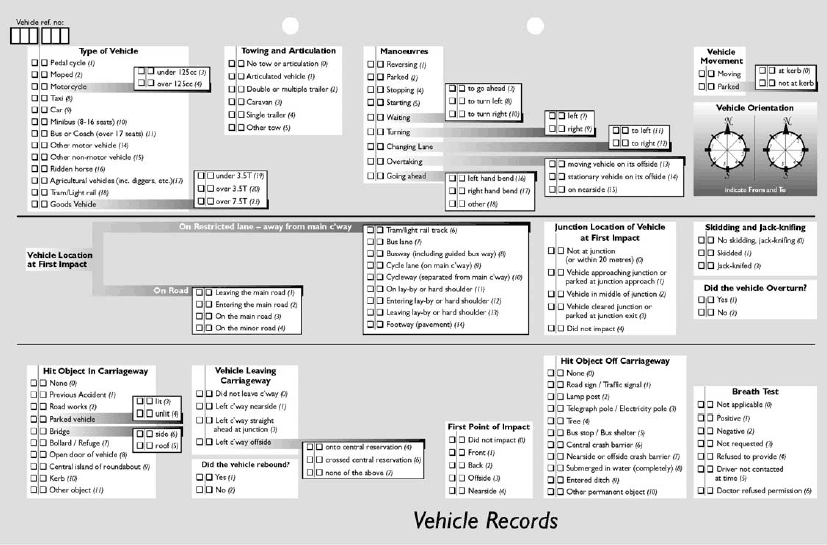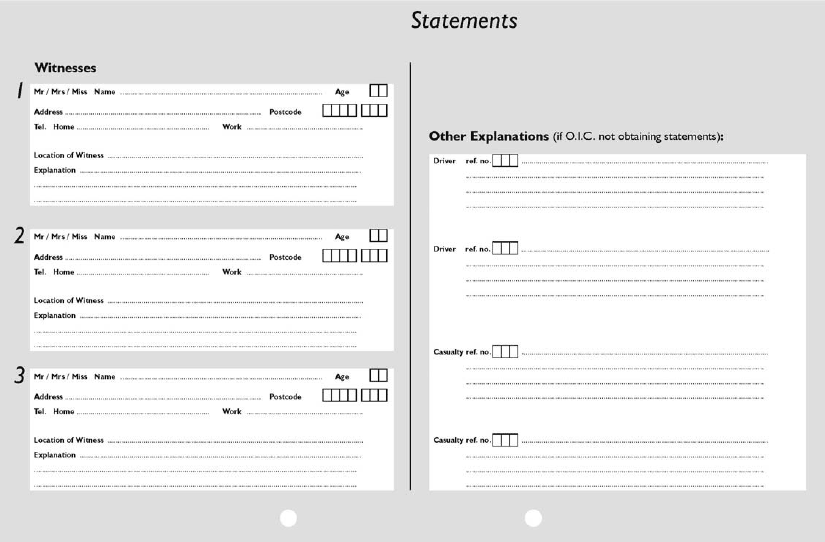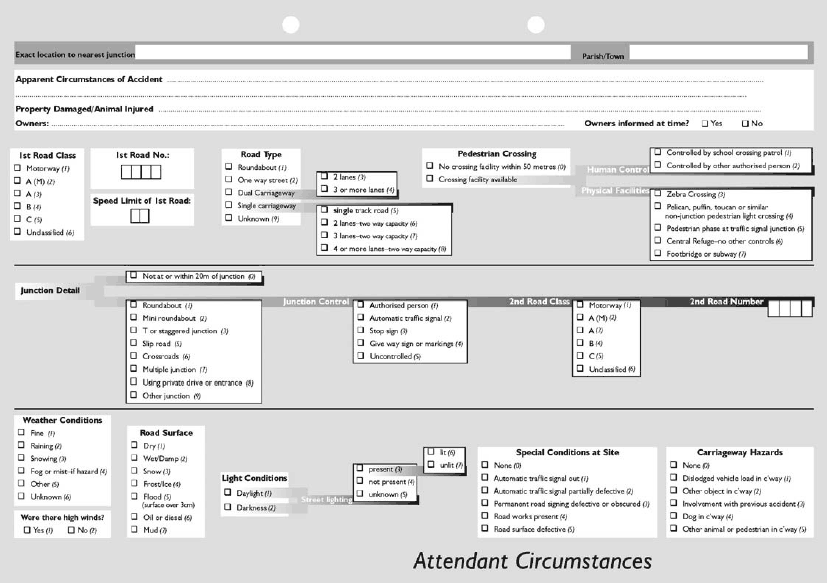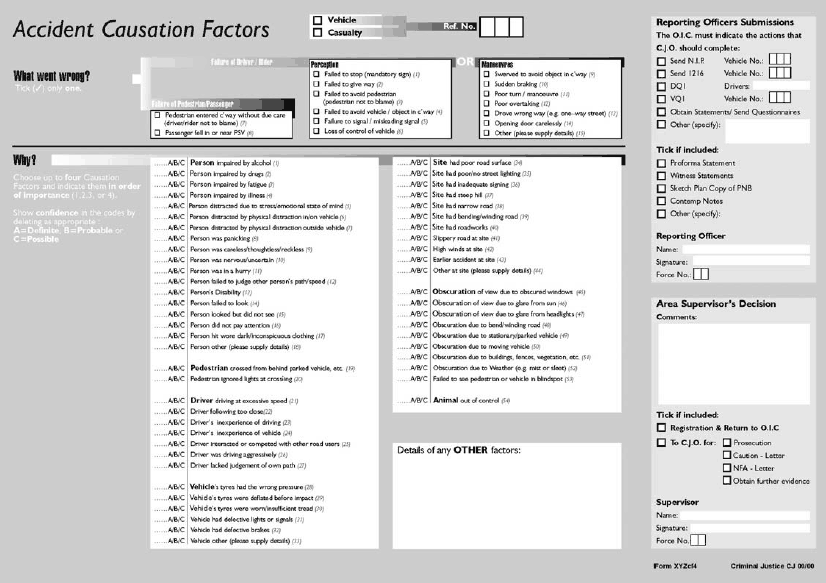Appendix B - The collection of road accident statistics, and examples of forms that could be used to collect the data
Reported Road Casualties Scotland 2017
Appendix B - The collection of road accident statistics, and examples of forms that could be used to collect the data
1. Introduction
This Appendix describes briefly the arrangements for collecting road accident statistics. It then provides examples of paper forms that could be used to collect the data.
2. The collection of road accident statistics
The Road Accident statistics are compiled from returns made by police forces. For each injury road accident known to have occurred in their areas, the police authorities complete a statistical return (named Stats 19), which provides details of the accident circumstances, separate information for each vehicle which was involved in the accident, and separate information for each person who was injured in the accident. Examples of the forms appear later and show details collected with effect from 2005, following the implementation of the changes recommended in the 2002 Quality Review (see Appendix C).
The statistical returns cover all accidents in which a vehicle is involved that occur on roads (including footways) and result in death or personal injury, if they become known to the police. It should be noted that the vehicle need not be moving, and need not be in collision – for example, the returns include accidents involving people alighting from buses. Road accidents in which no-one is injured (damage only accidents) are not covered by this definition, so the Transport Scotland (TS) does not receive details of such accidents, and this publication cannot give any figures for them.
Full guidance on the completion of the Stats 19 statistical returns, including detailed notes and definitions of the coverage of the returns and of the information to be provided in each field, is given in a document produced by the Department for Transport (DfT), called Instructions for the Completion of Road Accident Reports (which is also referred to as the Stats 20).
The returns for accidents in Scotland are submitted to TS every month by the police authorities, either directly or with the assistance of a local Council. All the returns should first be subject to the validity and consistency checks specified in a document called Procedures for Submitting Road Accident Data to The Scottish Executive. (also known as the Scottish Edition of Stats 21). TS also applies these checks, and clears any errors that it finds with the police. The returns are added to the TS Transport Statistics branch's database, which contains statistical information about all injury road accidents in Scotland since 1979.
The Transport Statistics branch's records for accidents which occurred on Motorways and A roads are copied to the Trunk Road Network Management Directorate of Transport Scotland, which maintains a database of information about trunk roads. From all the Motorway and A road accidents, the ones which occurred on trunk roads are identified using their road numbers and their grid co-ordinates, and the information about them added onto the Trunk Road Network Management Directorate database. The TS is subsequently informed which of these accidents occurred on trunk roads, and its database is updated accordingly.
Similar returns are made throughout Great Britain. TS sends a copy of the Scottish data to DfT, which holds a database of accident records for the whole of Great Britain.
Copies of the Stats 19 illustrative forms (see below) the Stats 20 and Stats 21 documents, a detailed list of all changes made at the start of 2005, and other documentation are available from the TS Transport Statistics Web site: see Data Sources and Methodology at: https://www.transport.gov.scot/our-approach/statistics#42755
A further review of the Stats 19 system took place in 2008. More changes were made to the collection of the data which took effect from 2013. A summary of the changes made by SCRAS can be found here http://www.transportscotland.gov.uk/system/files/uploaded_content/documents/research/DfT_2008_review_of_STATS_19.pdf
3. Examples of forms that could be used to collect the road accident statistics data
This Appendix provides examples of paper forms that could have been used to collect the data for the road accident statistics returns. Two types of form are shown:
a. the illustrative Stats 19 form – this shows only the information which is now collected for national statistical purposes;
b. an example of a more sophisticated form, which was developed by Middlesex University – this shows both the information needed for national statistical purposes and examples of the kinds of other details which may be obtained for local use.
In both cases, separate pages are used for information about the Attendant Circumstances, the Vehicles involved and the Casualties. For example, the illustrative Stats 19 form has a separate page for each Vehicle and a separate page for each Casualty. The Middlesex University form can hold details of two Casualties on one page, and details of two Vehicles (side by side) spread over two pages. What is sometimes referred to as an accident book would contain a number of such pages (when an accident involves more vehicles or more casualties than the book allows for, the officer can attach extra pages for the other vehicles and casualties). The Middlesex University form's pages differ in size, so that one can turn quickly to a particular page of the accident book.
In practice, each Police Force uses its own system, which may not involve the use of paper forms. For example, details of an accident may be recorded on a Personal Digital Assistant by an officer at the scene, or the information may be keyed into a computer by the officer or by the clerical staff whom the officer telephones to report the accident. However, some police forces have recorded the information required for statistical purposes using forms which were, for example:
a. based on the illustrative Stats 19, with slight modifications to include boxes to collect additional information for local use, such as codes for the reporting officer, the Police beat on which the accident occurred, and the school attended (if a casualty was a school pupil en route to or from school); or
b. in effect, a data preparation coding form with (e.g.) boxes for all the statistical information about the Attendant Circumstances, up to three Vehicles and up to four Casualties, and some information for local use, all on one double-sided A4 sheet. Anyone completing such a form would have to refer to a separate document for details of the codes for variables such as Road Class, Type of Vehicle and Pedestrian Location.
As well as such forms, the Police Force would, of course, hold other information about the accident (for example, in the officer's notebook, reports and administrative records).
4. The illustrative Stats 19 form (2013 onwards)
The first four pages of forms in this Appendix together make up the illustrative Stats 19 form. As mentioned, this shows only the information that is collected for the national road accident statistics. With the exception of the Contributory Factors, the forms show each variable's reference number (e.g. 1.7 for the Date on the Attendant Circumstance form; 2.5 for the Type of Vehicle on the Vehicle form), which identifies the relevant section in the Stats 20 Instructions for the Completion of the Road Accident Reports. A new version of the form is produced following recommendations of each Quality Review.
The recommendations from the latest review in 2008 has been implemented from January 2013. A revised illustrative STATS 19 form and the accompanying STATS 20 and STATS 21 guidance can be found here
https://www.transport.gov.scot/our-approach/statistics#42755
5. The Middlesex University form (based on the 1999-2004 Stats 19 specification)
The form shown on the remaining pages of this Appendix was developed by Middlesex University, as part of a research project The Development of Improved Methods for Representing Road Accident Data, funded by the Engineering and Physical Sciences Research Council. The research objectives included:
a. to define the accident attributes required for the more effective diagnosis and design of accident remedial schemes and to integrate these with the data required for the compilation of national accident statistics;
b. to investigate methods of data collection and to design a police accident report form which includes the required attributes and reflects an intuitive perception of the causes of particular accidents.
The researchers surveyed Police Forces, explored their methods of data collection, assessed the kinds of forms used, identified a number of deficiencies in their design, and developed the form which appears here. This was used on a small-scale trial basis by some officers in eight Police Forces: many found the form easy to complete once they were familiar with it. The researchers concluded that it would be difficult to produce a single form that satisfied the requirements of each police force, but forms based on sound principles of graphic design would be easier to complete and less prone to errors.
The researchers also considered an electronic version of the form for the internet, designed to be independent of platform, relatively easy to produce, and to include data validation and help menus.
The Middlesex University form is based on the Stats 19 specification that applied from 1999 to 2004, therefore does not take account of changes made with from 2005. The form also shows the kinds of information that may be collected for local use (e.g. boxes for the officer to tick to indicate whether the driving licence, insurance certificate are in order).
We are grateful to the researchers for permission to reproduce the form. For further information please contact:
Ken LuptonTransport Management Research Centre
Middlesex University, The Burroughs
London NW4 4BT
e-mail: k.lupton@mdx.ac.uk
Forms
Accident Record Attendant Circumstances
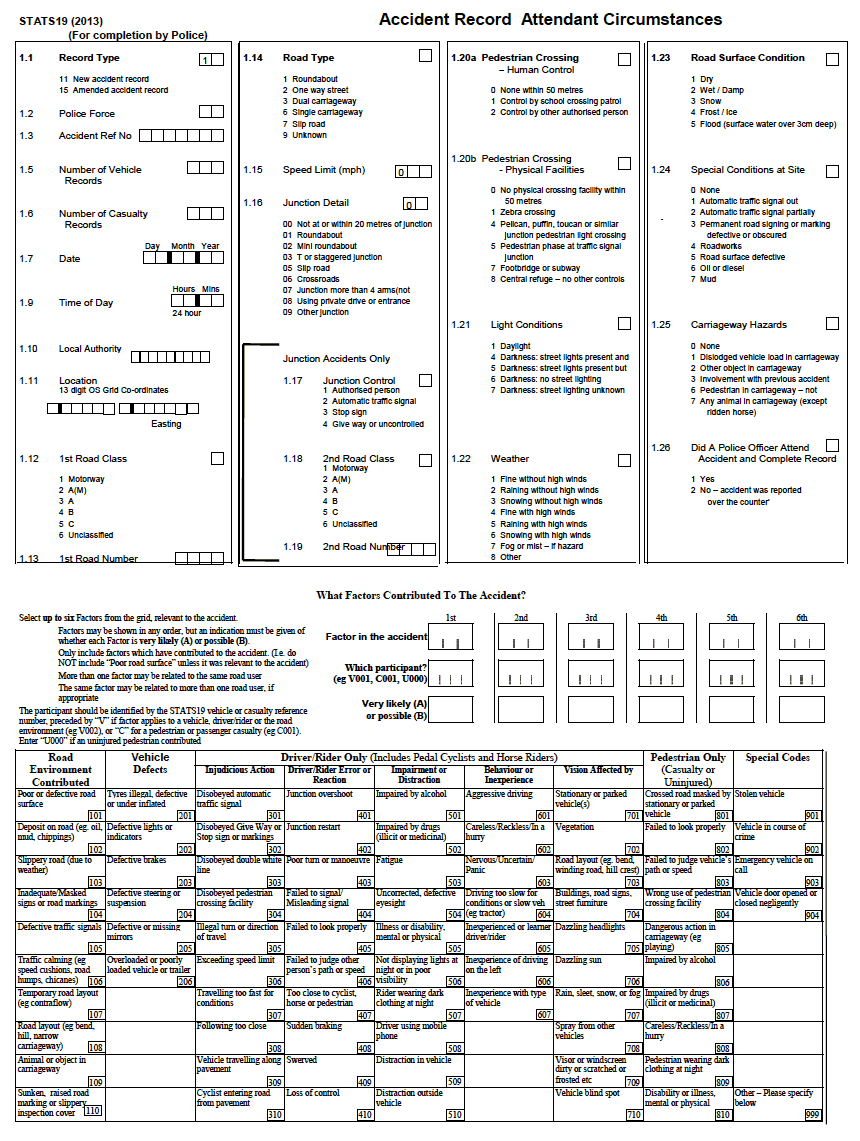
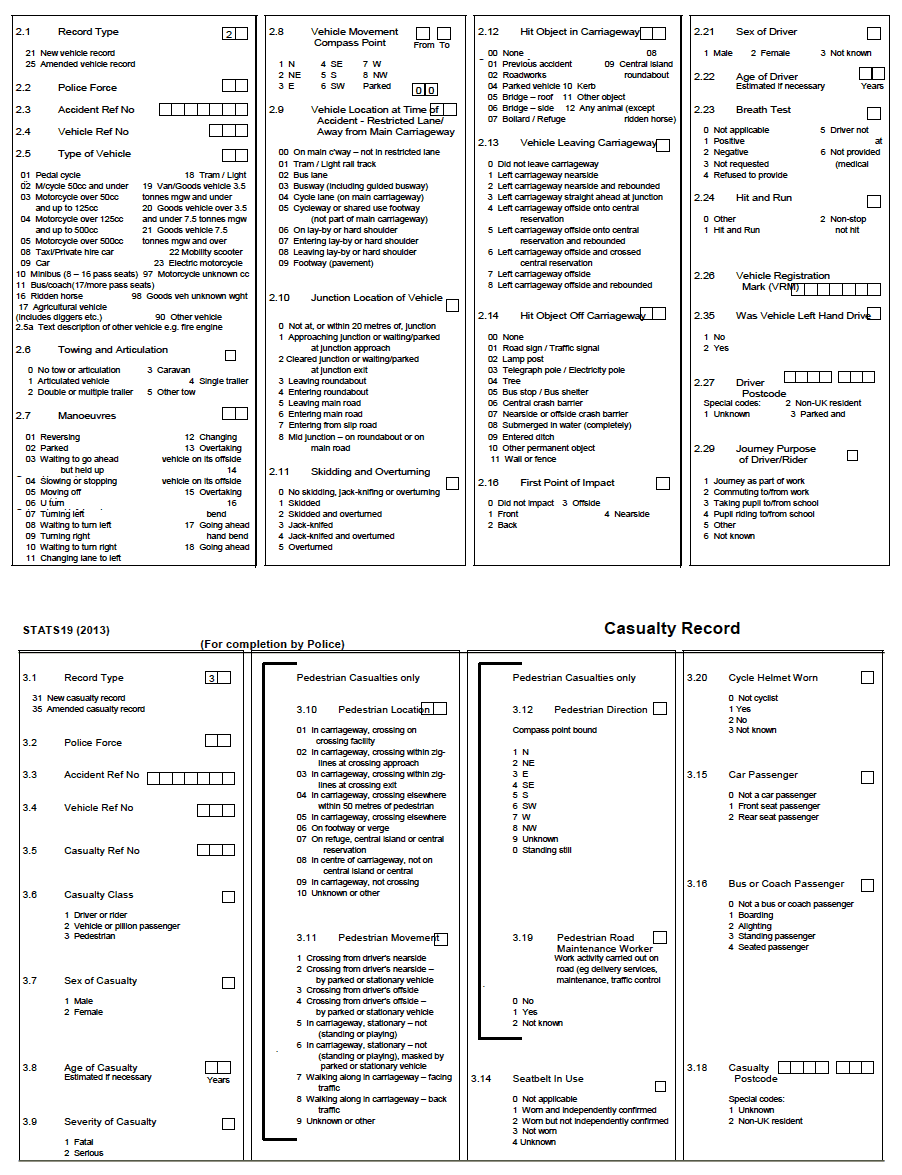
Accident Record
